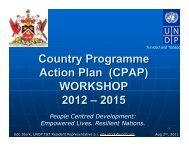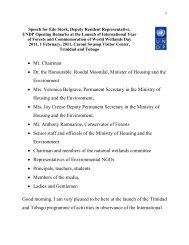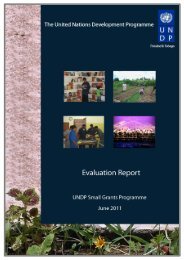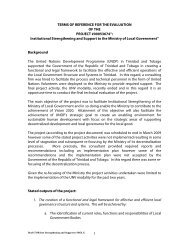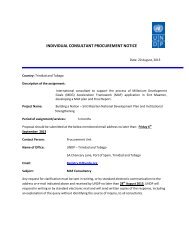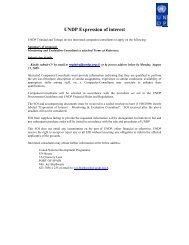The View from the Boardroom - UNDP Trinidad and Tobago
The View from the Boardroom - UNDP Trinidad and Tobago
The View from the Boardroom - UNDP Trinidad and Tobago
Create successful ePaper yourself
Turn your PDF publications into a flip-book with our unique Google optimized e-Paper software.
<strong>The</strong> <strong>View</strong> <strong>from</strong> <strong>the</strong> <strong>Boardroom</strong> - CEO Study on Corporate Social Responsibility in <strong>Trinidad</strong> <strong>and</strong> <strong>Tobago</strong>CHAPTER 3<strong>The</strong> Third Sector Revisited – Private Sector <strong>and</strong> Nonprofit Partnershipsbetter home. Habitat is involved inall that so <strong>the</strong>y are a natural fit.” Thistype of congruence has been describedby some experts as a ‘cause fit’ which“involves a compatible positioningbetween <strong>the</strong> company <strong>and</strong> <strong>the</strong> causethat is based on an element of strategicsimilarity”. 31Contrasting with such an approachthat seeks to align a company’score business with its partnershipidentification <strong>and</strong> selection process,o<strong>the</strong>r corporate actors deal with<strong>the</strong> issue of nonprofit partnershipsin a more ad-hoc, reactive <strong>and</strong> lessformalised way. Michael Aboud,CEO of Amalgamated Security Ltd.explains: “<strong>The</strong> NGOs that we workwith would be <strong>the</strong> Living Waterscommunity <strong>and</strong> we would normallyrespond with whatever <strong>the</strong>y need<strong>from</strong> us. For example, if <strong>the</strong>y havea fair <strong>and</strong> <strong>the</strong>y want security or <strong>the</strong>ywant us to incorporate some of <strong>the</strong>irpeople in our mentoring programme<strong>the</strong>n we would facilitate that. We have,however, no formal agreement withany of <strong>the</strong> NGOs. We see NGOs as<strong>the</strong> conduits through which we canexecute some of our projects. If weare talking to our managers aboutour social engagement, we would ask<strong>the</strong>m to identify through <strong>the</strong> NGOs<strong>the</strong> things that <strong>the</strong>y would like to seehappening <strong>and</strong> to see if we can getinvolved in that. But it’s not formal.<strong>The</strong>y are important but <strong>the</strong>y are alsovery focused in what <strong>the</strong>y want todo which is not necessarily what Iwant to do. If <strong>the</strong> alignment is not<strong>the</strong>re, <strong>the</strong> project may never happenthrough <strong>the</strong>m. So <strong>the</strong>y may come tous with something where we feel thatthis is something that <strong>the</strong>y can do on<strong>the</strong>ir own <strong>and</strong> <strong>the</strong>y don’t need to bein partnership with us.” And askedabout <strong>the</strong> same aspect of formal <strong>and</strong>long-term partnership arrangementsbetween <strong>the</strong> world of profits <strong>and</strong><strong>the</strong> world of societal development,Norman Christie, President of bpTTelaborates: “Globally, <strong>the</strong> partnershipsbetween companies <strong>and</strong> NGOshaven’t really always focused on <strong>the</strong>notion of sustainability. Somehow <strong>the</strong>relationship tends to be in itself shorttermin focus. So, I believe that anevolution is required. NGOs might beevolving <strong>and</strong> might be getting betterbut <strong>the</strong>re are even more possibilitiesto develop that space so that when we(i.e. companies <strong>and</strong> NGOs) are talkingit is really a conversation about apartnership on long-term sustainableissues.”Since companies <strong>and</strong> nonprofits hail<strong>from</strong> different organizational cultures,<strong>the</strong> room for misunderst<strong>and</strong>ings,misaligned expectations, attemptsat dominating joint activities or <strong>the</strong>divergence of targets <strong>and</strong> objectivesis considerable. Suspicion, mistrust<strong>and</strong> apprehension are <strong>the</strong> likely byproductsof partnerships that lacksufficient preparation, information<strong>and</strong> expectation management.<strong>The</strong> problem of corporate micromanagingor at least <strong>the</strong> perceptionof corporate micro-managing ashighlighted in <strong>the</strong> previous casearises predominantly in situationsin which <strong>the</strong> company decides toadopt a programmatic approachinstead of pursuing a philanthropic<strong>and</strong> grant-making model of supportfor social <strong>and</strong> environmental causes.Combining <strong>the</strong> two approaches,Nicolas Galt, President of <strong>the</strong> TSLGroup of companies says abouthis company’s support for nongovernmentalorganisations: “Inso far as NGOs are concerned,our involvement has been largelymentoring, time based <strong>and</strong> somewhatfinancial. We use our experience inbusiness <strong>and</strong> our ability to underst<strong>and</strong>a business proposition to adviseyoung start-ups how to deal with this.“Managing expectationson both sides of <strong>the</strong>partnership withregards to <strong>the</strong> levelof organizationalcommitment, to <strong>the</strong>output produced <strong>and</strong>outcomes generated aswell as to <strong>the</strong> resourcesallocated will determineif volunteer projectsbecome reasons forcelebration or a triggerfor corporate hang-over.”Roadmap to CorporateVolunteering- 6 Steps Towards Developingan Employee VolunteerProgramme<strong>UNDP</strong> <strong>Trinidad</strong> <strong>and</strong> <strong>Tobago</strong>201131 Ida E. Berger, Peggy H. Cunningham, Minette E. Drumwright, ‘Social Alliances: Company/Nonprofit Collaboration’, California Management Review, Vol.47, No.1, Fall 2004, p.74.51





